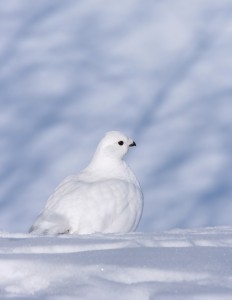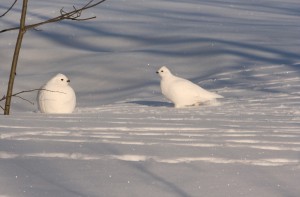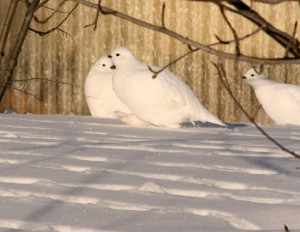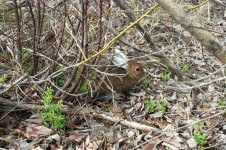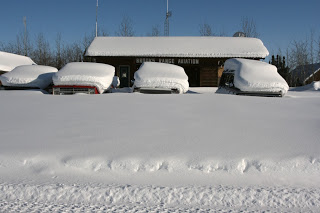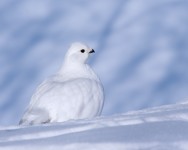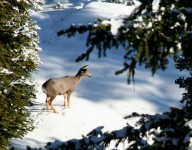The occasional cluck will draw attention to the position of a ptarmigan along with their numerous tracks in the snow but seeing the ptarmigan isn’t easy. During winter, ptarmigan outfit themselves in white feathers which enable them to blend seamlessly into the snowy landscape and look like mounds of snow. A relative of the grouse, ptarmigan (pronounced without the ‘p’) are masters of camouflage year-round.
One flock has been hanging around Bettles and the first time I spotted them I counted a dozen. But once they took flight, I counted twenty. Their initial rapid wing beats don’t startle me as much as a grouse but they seem to mock me with their laugh-like cackling.
Large flocks are common in the winter as they move between sheltered areas and feeding areas. Amazingly, ptarmigan can survive on buds and catkins from willow and birch during the winter.
They have several techniques to stay warm and minimize energy expenditure so they don’t have to find as much food. First of all, they have a layer of down feathers between their skin and outer feathers, creating a down coat—which is still needed this time of year. They also fluff up the feathers in that down layer to create more air spaces which increases the insulating effect.
Secondly, ptarmigan grow feathers on their legs and feet, even the soles of their feet. The only other bird with fully feathered legs and feet is the snowy owl. Not only do the feathers on the soles of their feet act as foot-warmers but they also act as snowshoes. Ptarmigan feed by running around on the top of the snowpack between branches and their ‘snowshoes’ keep them afloat. They even have built-in traction because they grow extra-long claws during the winter to help with the snowshoe effect. Come spring they will shed the long claws and grow shorter ones along with a mottled brown coat.
Ptarmigan don’t molt to a complete brown like grouse, instead they keep their white wings and belly. As ptarmigan molt, they seem to know which color they are (brown or white) because studies have shown that ptarmigan will chose to rest in a spot that matches their dominate color—white on snow and brown on bare ground.
One other technique that ptarmigan use to escape the cold (along with grouse) is to dive into the snow from the air—so they don’t leave tracks to attract predators—and create a small burrow under an insulating blanket of snow to spend the night.
As I was watching a flock of ptarmigan in a small patch of birch, I noticed a dark head pop out of the snow nearby. As I continued to watch, a ruffed grouse climbed out of its snowy burrow and flew up to a low limb. Neither the grouse nor the ptarmigan seemed to notice one another. As I crept closer, the ptarmigan flew off cackling and the grouse remained.

